Please Take Note: This is a review of the final game, but it might change slightly based on the success of the Kickstarter campaign. The game is being reviewed on the components and the rules provided with the understanding that “what you see is not what you might get” when the game is published. If you like what you read and want to learn more, we encourage you to visit the game publisher’s website or visit the Kickstarter campaign. Now that we have all that disclaimer junk out of the way, on with the review.
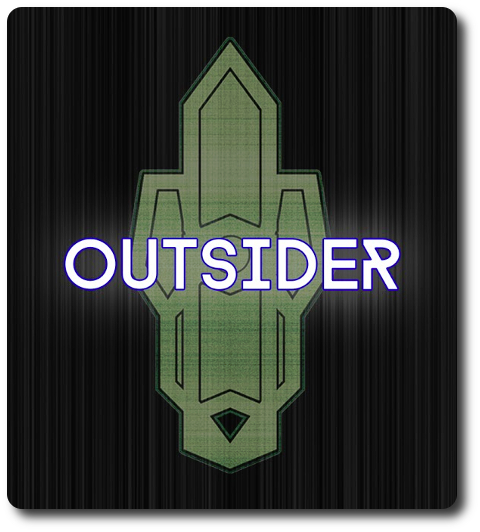
The Basics:
- For ages 8 and up (publisher suggests 12+)
- For 3 to 6 players
- Approximately 60 minutes to complete
Geek Skills:
- Active Listening & Communication
- Counting & Math
- Logical & Critical Decision Making
- Reading
- Memorization & Pattern/Color Matching
- Strategy & Tactics
- Risk vs. Reward
- Cooperative & Team Play
- Hand/Resource Management
- Bluffing and Misdirection
Learning Curve:
- Child – Easy
- Adult – Easy
Theme & Narrative:
- The darkest place in existence is not space, but the mind of man
Endorsements:
- Gamer Geek approved!
- Parent Geek mixed!
- Child Geek rejected!
Overview
Use of Dark Gravity allowed mankind to travel between the stars in seconds. But such freedom comes with a heavy price. Each shift in time and space removes a little bit of reality and replaces it with something else. Something sinister. The mind begins to unravel and it becomes impossible to tell who is a friend and who is a foe.
Outsider, designed by William Lewis Cox and to be published by Acronaut Games, will reportedly be comprised of 10 Character cards, 9 Loyalty cards, 2 Deck Indicator cards, 20 Event cards, 20 Gear cards, 16 Goal cards, 2 Gravity Shield cards, and 16 Dark cards. As this is a review of a prepublished game, I will not comment on the game component quality. The illustrations by James Zark further accentuate the game’s dark and gritty Science Fiction theme and disquieting narrative. Not included with the game, but necessary to play, is a pen or pencil and some paper to help keep track of damage and other dangers. Tokens also work very well.
Preparing to Shift
To set up the game, first collect and place into a single deck all of the cards with the “Outsider” card back. This is the Main deck and it contains the Gear, Goal, Gravity, and Dark cards. Shuffle the Main deck and place it face-down in the middle of the playing area, making sure there is room for a discard pile.
Second, take the Event cards and shuffle them. Place the Event cards face down to form a single deck next to the Main deck. This is the Event deck. Make sure there is room for a discard pile.
Third, take the “Supply” and “Entropy” Deck Indicator cards and place them next to the Event deck. Cards will be placed on top of these two Deck Indicator cards and orientated so the title of each Deck Indicator card is always visible.
Fourth, give each player 1 Character card. Players can select their own or a Character card can be assigned at random. Place any Character cards not being used back in the game box. All players should take a few minutes to familiarize themselves with their own Character card and those being used by other players.
Fifth, take the Loyalty cards. If playing with 3 or 4 players, separate 1 “Outsider” Loyalty card and either 2 or 3 “Crew” Loyalty cards. If playing with 5 or 6 players, separate 2 “Outsider” and 3 or 4 “Crew” Loyalty cards. The end result should be no more than 1 Loyalty card per player in the game. Shuffle the Loyalty cards and deal 1 to each player, making certain the Loyalty type (Outsider or Crew) remains hidden. This is the player’s secret persona. Any Loyalty cards not used should be returned to the game box.
Sixth, deal 6 Main deck cards to each player, face-down. Each player looks at their cards and selects 1, placing it face-down in the middle of the playing area to form the Supply. One player should collect these cards, and without looking, place them face-down on the “Supply” Deck Indicator card.
Seventh, place the tokens or pen and paper to one side of the game playing area and within each reach. These will be used to help keep track of how well the Characters are surviving.
That’s it for game set up. If the “Captain” Character card has been selected, the owning player is the first player for the game. If the “Captain” is not present, select a first player and begin.
In the Light, Darkness
There are a number of different cards in the game and each has a specific use. Each are summarized here.
Character Cards
Each player’s Character card is unique and brings to the game a number of Skills that can be used to either help or hinder. Each Character card also has special abilities that can be used on the player’s turn. Players will need to know what their Character and their opponents’ Characters can do, as well as what they cannot do in order to obtain their Goals. For example, the “Security” Character card has the ability to “attack” another player’s character or look through their hand. Very powerful and possibly alarming to the rest of the Crew, if the player starts acting suspicious.
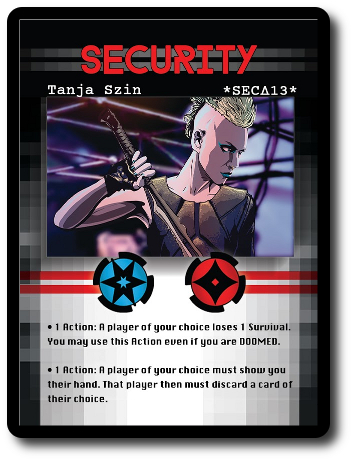
Loyalty Cards
Each player is given 1 random Loyalty card at the beginning of the game and told to keep it secret. Unless otherwise forced to reveal the card during the game, the player’s true loyalties will never be clear until the end of the game.
In simplest of terms, those with the “Outsider” Loyalty cards are hellbent on destroying the Crew, but they must do so in a way that does not draw suspicion. Players with the “Crew” Loyalty cards are all working together to keep the spaceship in on piece and determine who is sabotaging their efforts.
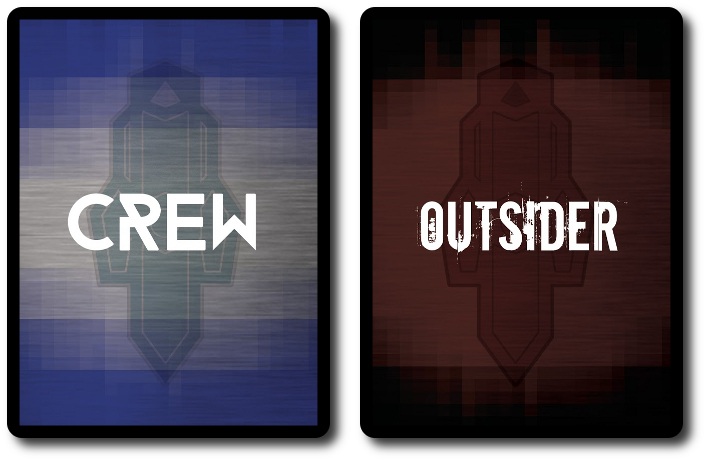
The most troubling aspect of the game is that the Outsider acts, talks, and plays like a normal Crew member. There is nothing outwardly apparent to suggest that the Character to the left or right of you has completely lost their mind.
Gear Cards
Gear cards represent the different pieces of equipment scattered about the spaceship. These need to be collected to complete Goals. Each Gear card identifies what Goal it should be used for, providing the Crew the necessary information to quickly repair the spaceship and the Outsiders all they need to know about what is essential for survival.
The equipment noted on the Gear cards can be Scrapped. This action discards the Gear card and provides additional Scrap values (noted as symbols). The Scrap can then be used to complete other Goals and might provide benefits if a player were to use an action that allowed them to gather supplies. Scrap must be used in the same turn it’s created. If it’s not, it’s sent to the discard pile and lost.
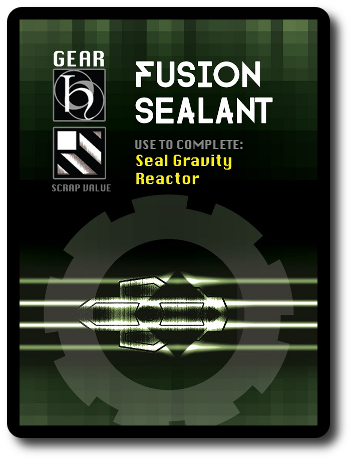
Goal Cards
Goals represent specific tasks that are focused on the survival of the spaceship and its crew. Goals are completed by using a Character’s Skills and providing the necessary Gear cards and Scrap. If the Goal is completed, the Goal provides a “Goal Bonus” that provides an immediate boon and a possible later benefit, as well. It all depends on the loyalty of the player who has the card.
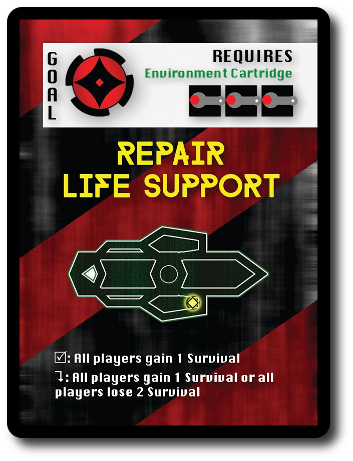
Event Cards
Events represent the chaotic happenings about the spaceship that are out of the players’ control. Events are triggered by Dark cards, either when they are drawn or when over half the Supply is comprised of Dark cards.
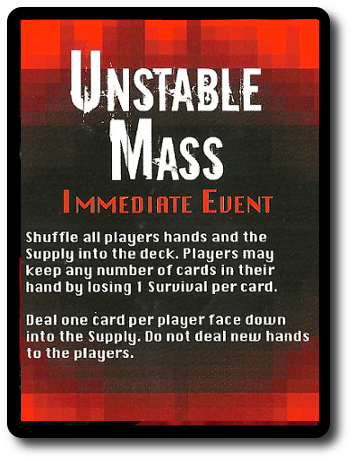
Event cards are read out loud and then resolved. Until the Event is fully resolved, all other cards in the game are temporarily put on hold. This includes other Event cards. Some Event cards will only remain in the game until resolved while others will remain in the game indefinitely as indicated by their “Ongoing” keyword.
Dark Cards
The process of warping space and time using the Dark Gravity technology slowly destroys a person’s mind. Prolonged or frequent space travel brings about paranoia, hallucinations, depression, and strong feelings of detachment. This slow decent into insanity is referred to as going “Dark”.
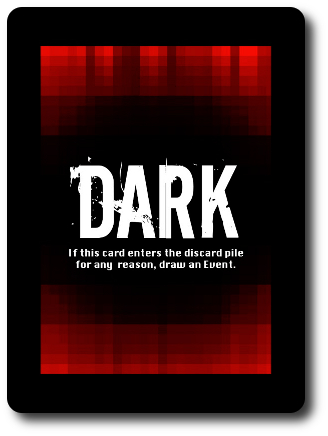
Outsiders do not perceive the world around them as the true reality. Friends are enemies, up is down, and the only path to salvation is to venture further into the darkness. In short, they are in Hell. Heavy stuff.
The Dark cards present this gradual build up of cosmic forces that humanity has tampered with and what is slowly eating away the sanity of each player Character’s mind. The more Dark cards in play, the more difficult it will be to keep track of what is real and what is not.
Spaceship Supply and Entropy
The “Supply” Deck Indicator card holds a “Common Hand” that all the players can use. Thematically, the cards in the Supply represent things that can be found in the spaceship’s storage. A player can use the Gather Supply action to look at the Supply cards and swap out cards from their own hand. As such, the Supply is the central point where players can drop off important Gear cards so the right person can collect them to achieve goals. Of course, the Outsider knows this and quietly loads the Supply with Dark cards. When Dark cards go to the Supply, an Event card is drawn. But the Outsider is not the only player who will drop Dark cards. Sometimes a loyal member of the Crew will need to deposit Dark cards to make room for necessary Gear cards.
The “Entropy” Deck Indicator holds cards and never lets them go. Entropy represents the spaceship’s structural integrity. After each player’s turn, a card from the Main deck will be draw and placed face-down on the “Entropy” Deck Indicator. When a card cannot be placed, the spaceship’s hull collapses and all players lose the game.
Survival and Doom
Characters in the game gain and lose Survival points. Think of these as “Health”. Players will get hurt and lose Survival points in the process, but they can also spend Survival points to gain advantages. In this way, Survival points are a bit more than just a number to be watched. They are a sort of currency that can be spent for the betterment of the crew and the survival of the spaceship.
If a player ever runs out of Survival, their Character becomes Doomed. Doomed Characters are not dead and the player continues with the game. Indeed, Doomed Characters can still win the game!
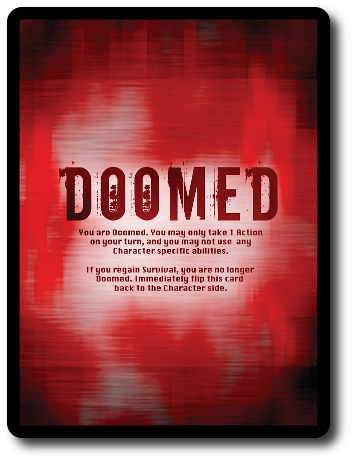
What Doomed Character cannot do is hope to survive the trip home. Nor can they use their abilities. They are also limited to only 1 action point per turn. But wait, there’s an upside. Since the Character no longer has any Survival points, they cannot lose any Survival points. Players would be wise to remember this fact, as they can use another Character’s Doomed status to do some rather dangerous work without fear of making things worse.
Players keep track of which Character is Doomed or not by flipping over their Character card. If the player’s Character is ever given Survival points, they flip from Doomed to their normal state and can once again fully use their Character’s Skills, abilities, and actions.
Through Space Darkly
Outsider is played in turns with no set number of turns per game. On a player’s turn, they will be able to take up to 2 actions and must complete 3 sequential steps. A player’s turn is summarized here.
Step 1: Take Two Actions
A player is given 2 action points to spend. Some actions will only cost 1 action point and more complicated actions will cost 2 action points. How the player spends their actions points and what actions they want to use is up to them and based on what their Loyalty card is. Event cards will also help players determine where they should put focus. Unspent action points cannot be saved for later.
Complete a Goal (Cost: 2 Action Points)
If the player is able to complete a Goal card by having the necessary Skills, Gear, and Scrap, they may reveal the cards and announce they have completed the current goal. The player then collects the Goal Bonus and the Goal card.
Now this part is very important, so listen up. Only 1 player can complete a Goal. They must have everything they need in order to do so, meaning players must work together using the Supply and Character abilities to move Gear and Scrap into the hands of the right player who has a Character card with the correct Skills. Sound tricky? It is, but the entire process is made a lot easier if everyone works together.
Play a Goal (Cost: 1 Action Point)
If the player has a Goal card in their hand, they can play it to the table. The previous Goal (if any) is discarded. A player can choose what is discarded, however. Either the Goal card they are playing or the Goal card already played.
Gather Supplies (Cost: 1 Action Point)
The player grabs all the cards from the “Supply” Deck Indicator card and swaps out 1 Supply card with any 1 card from their hand. Before doing so, the player counts the number of Dark cards. If over half the cards are Dark cards in the Supply, the Supply is revealed to all the players and then 1 Event card is drawn and resolved before the player continues their turn. After the Event is resolved, the player takes 1 card from the Supply and swaps it with 1 card from their hand as normal.
Scrap to Heal or to Reshuffle (Cost: 1 Action Point)
The player can discard Gear cards for a combined total of 3 similar Scrap symbols to gain 1 Survival or the player can discard Gear cards for a combined total of 3 different Scrap symbols to shuffle the discard pile back into the Main deck.
Discard and Draw (Cost: 1 Action Point)
The player discards any number of cards in their hand and then draws back up to their hand size limit. A player need not discard any cards if they do not want to before drawing additional cards. If, however, a Dark card is discarded, the player must draw an Event card and resolve it before continuing.
For the most part, players are not allowed to have anymore than their hand limit size at any time. If they do, they must discard down.
Declare Victory (Cost: 1 Action Point)
If the player believes the victory conditions have been met, the player can declare victory.
Step 2: Spend Survival, Gain Actions
The player can reduce their Survival by -1 to obtain +1 action point, but the cost increases each time the player does so on their turn. The first time the player need only reduce their Survival by -1, the second time it’s reduced by -2, and so on.
Thematically, the player’s Character is truly risking their life to achieve a goal. How heroic, if not foolhardy.
Step 3: Build Entropy
The last thing a player does is draw 1 card from the Main deck and add it to the Entropy pile.
This ends the player’s turn. The next player in turn order sequence now goes.
Victory and BOOM!
The game can end four different ways.
The worst way is that a card cannot be added to the Entropy pile during a player’s turn. The spaceship implodes and every Character on it dies. No one wins the game.
The second worst way is that an Event calls for all the players to lose Survival points, but all the player Characters are already Doomed. In which case, they are über doomed. Supper doomed. Doomed doomed! The spaceship and all within it are lost to the Dark for eternity. No one wins. Boo!
If there are more completed Goal cards that then there are players and each “Crew” Loyalty player has completed at least 1 Goal card, the “Crew” Loyalty card holders win the game. To determine if they do, a player must declare victory at the end of their turn. All Loyalty cards are then revealed. If the above victory conditions exist, the “Crew” wins the game. If not, each “Crew” player must now draw 1 Event card and resolve it. But before doing so, the “Outsider” gets to look at the top Event card and decides which “Crew” must resolve it.
The “Outsider” wins if all the “Crew” players have Doomed Characters, but at least 1 “Outsider” (if 2 are in play) must not be Doomed, as well. If the “Outsider” player thinks their victory condition exists, they declare victory and Loyalty cards are revealed. If the “Outsider” is successful, they win. If not, the Loyalty cards remain face-up and the game continues.
Game Variants
A small number of game variants are available for players to use or completely ignore. Each are summarized here.
The Omega Protocol
This game variant removes the possible ending of the game where none of the player’s win due to the spaceship blowing up. The spaceship takes over and forces a shift. This saves the spaceship, but not necessarily all of the crew. Reality shifts (some “Crew” might become “Outsiders”) and things go pretty weird. Victory is now dependent on how many Goals are completed and how many Characters are Doomed.
Final Confrontation
This game variant pits the “Crew” against the “Outsider” in a thematic final struggle when the game comes to an end due to Entropy or Events. Points are counted and the loyalty side with the most points wins.
The Quick and the Dead
A Character is no longer Doomed in the game. If they Character runs out of Survival points, they are Dead. The Character is set aside and the player draws a new one, including a new Loyalty card. The game then continues as normal. The “Outsider” player can win the game if there are ever more dead Characters than surviving Characters.
To learn more about Outsider, visit the game publisher’s website or visit the Kickstarter campaign.
Final Word
The Child Geeks had a very hard time with this game. While they all understood how to achieve the two different victory conditions (depending on the player’s loyalties), they struggled to achieve any real semblance of momentum. They took too long to complete Goals and did not work well as a team. According to one Child Geek, “I want the other players to help, but I don’t know if they are trying to help and can’t or they are the bad guys.” The growing amount of frustration eventually turned all the players against each other. Another Child Geek said, “The most frustrating thing about this game is simply getting people to be a team. No one is doing what they are supposed to be doing!” And then, in the game’s final moments, before the spaceship exploded, all of our Child Geeks were ready to flip the table. As one Child Geek put it, “This game is impossible!” And then, with the entire crew of the spaceship at each others throats, the spaceship disintegrated, silently in the vacuum of space. Tremendously epic, really, and true to the game’s theme, but it frustrated the Child Geeks to a point of near exhaustion and tears. The Child Geeks unanimously agreed that Outsider was not a game they enjoyed.
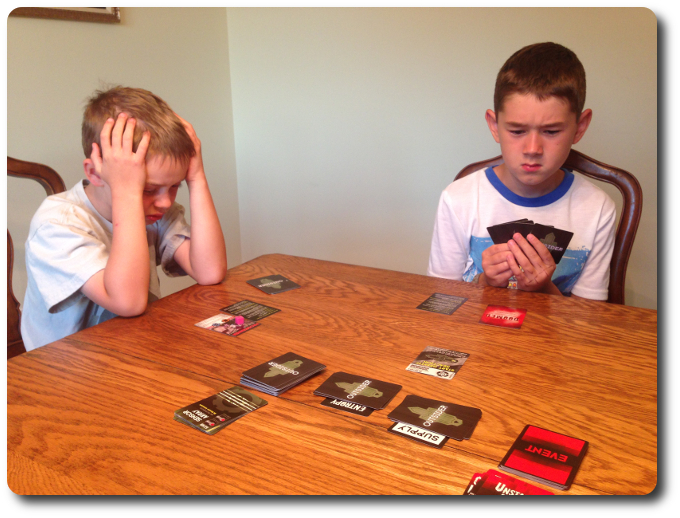
One Child Geek holds his head in frustration, while his older brother looks very bewildered
The Parent Geeks were another story. The game was easy to teach and everyone understood what was expected of them. The only problems they had were logistics and working as a team. One or two players would always rise above the chaos in an attempt to direct the masses, as is the case in most Cooperative and Semi-Cooperative games, but this only lead to more issues. The biggest problem, as I saw it, was one of mistrust. You simple do not want to give too much away and that tends be a real detriment to the cooperative process necessary to win the game. As one Parent Geek put it, “I want to win and I know everyone around me wants to win. The problem is, I don’t know how they want to win.” Another Parent Geek said, “I’ve played as both Crew and Outsider and I have no idea which is harder or more fun. They both are challenging and both are frustrating.” Frustrating and fun? Oh, yes! Those Parent Geeks who enjoyed a heavier game with more player interaction very much enjoyed Outsider. Those Parent Geeks who only wanted to play a casual game with easy-breezy game play found Outsider to require more effort than they wanted to provide. The end result was a mixed endorsement from the Parent Geeks.
All the things that made Outsider a game difficult to play and enjoy for the other groups made the Gamer Geeks happy. According to one Gamer Geek, “Knowing if an opponent is a member of the Crew or an Outsider is not as important as you might think. What you need to know is if the player is the kind of person who likes to take calculated risks or just likes to take things as they come. You can use both types of people, but you need to know which you are dealing with.” When I pressed for more information, it turns out the Gamer Geek was alluding to understanding how the player would go about managing the Dark and the Goals. Another Gamer Geek said, “Great little card game. Stays at the table a bit too long at times, but it’s devilishly hard to win and is a real challenge. I like it.” And finally, one Gamer Geek wanted to add, “Like all games full of deduction and hidden traitors, the goal is to determine which side each player is on, but this game takes it a bit further. Both friend and foe have to work together to a certain degree, not giving up too much an advantage in the process. But it’s a game of give and take. I really enjoyed it.” When all the votes were in, the Gamer Geeks voted to approve Outsider.
Here is a game for those who enjoy feeling pushed to make important decisions with very little information to go on. It’s a game where the player is not only challenged to critically and logically consider all the possibilities, but also dread every outcome. This is not a game for those who want casual entertainment. Oh, no, dear friends. Outsider is a game that plays tough and hits below the belt.
The very first thing a player should do, regardless of their loyalties, is get a Goal in play and worked on. The spaceship is going to implode before too long and no one wins if that happens. Brilliantly, the different loyalties have to work together to a certain degree to keep everything running. This was a neat twist as it forced the Outsider to truly contribute to the cause, albeit in a way that would lead to partial success for the Crew. Likewise, the Crew needed the Outsider to help to a certain degree or they wouldn’t survive, meaning the Outsider was given a certain amount of calculated freedom.
I found Outsider to be an entertaining game, but only with the right crowd. When I played with the Child Geeks and non-gamers, Outsider was a painful experience. When I played the game with the Parent Geeks and casual players, the game felt too long and it was obvious that some of the players didn’t care for it. Playing with the Gamer Geeks and more experienced players was a lot of fun, as everyone got into the spirit of the game and attempted to beat the odds.
Clearly, Outsider is not for everyone. This is a special game for a special kind of gamer who doesn’t mind being hit repeatedly and asking for more. This is not an easy game, but it can be beaten. Players who do play it will quickly learn that it’s not the game that will challenge them, but the players’ inability to work together. The Dark in this game is self-doubt and it will creep into the minds of every player, slowly making them hesitate and then second-guess. Hesitate too long and all is lost.
This is a paid for review of the game’s final prototype. Although our time and focus was financially compensated, our words are our own. We’d need at least 10 million dollars before we started saying what other people wanted. Such is the statuesque and legendary integrity of Father Geek which cannot be bought except by those who own their own private islands and small countries.




Thanks for the great write up! I’m always blown away by how thoughtful and articulate your reviews are – keep on raising the bar!
Thank you very much for your kind and supportive words!